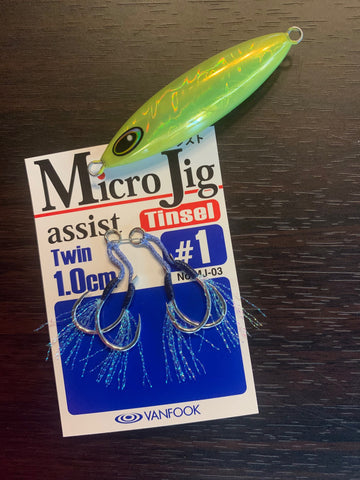Las técnicas de jigging vertical más populares en Estados Unidos son el micro jigging, el jigging ligero y el jigging de paso lento.
Debes utilizar el Assist Hook correcto para cada técnica, minimizando el peso extra de los anzuelos y maximizando el trabajo de los jigs .
A continuación se detallan las pautas básicas para el correcto uso de los Assist Hooks en cada modalidad de Vertical Jigging:
1 - Micro Jigging:
El microjigging, considerado como una pesca con jigs ligeros de entre 3,5 g y 25 g, requiere el uso de anzuelos más pequeños y ligeros. A menudo se añaden destellantes para atraer a los peces con mayor facilidad.
Aunque pequeños y ligeros, los anzuelos deben ser resistentes, pues aunque el jig sea pequeño, suelen atraer peces fuertes y de tamaño mediano.
2 - Jigging ligero:
El jigging ligero utiliza jigs con pesos inferiores a aproximadamente 100 g. En esta modalidad, el jig no solo se trabaja en el fondo, sino en toda la columna de agua, siendo una de las técnicas de jigging vertical más versátiles. Contrariamente a lo que muchos creen, la pesca con jigging ligero también permite capturar peces de tamaño relativamente grande, como medregales de más de 9 kg, lo que requiere mucha técnica y anzuelos bien reforzados.
3- Jigging de lanzamiento lento:
Para la modalidad de jigging vertical más popular en América, hay que prestar atención a la ligereza y al largo correcto del anzuelo.
Las buenas marcas de anzuelos ofrecen diferentes tamaños de anzuelos de asistencia que te ayudarán a la hora de elegir el mejor para tu Jig.
El uso de cuatro anzuelos distribuye mejor el peso del pez al sacarlo a la superficie. Por lo tanto, recomiendo usar un anzuelo doble en la parte delantera y otro doble en la trasera.
Consejo: El anzuelo de asistencia debe tener aproximadamente 1/3 del tamaño de su plantilla.
Como última opción, y un poco más refinada, puedes armar tus propios anzuelos de asistencia, eligiendo entre los diferentes materiales y marcas disponibles en el mercado, cada uno con sus propias características. Cuerdas para anzuelos de asistencia con o sin fluorocarbono, alambres, tubos termorretráctiles, diferentes curvas de anzuelo... pero este tema lo trataremos en otro artículo.






